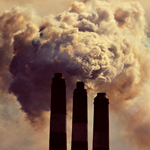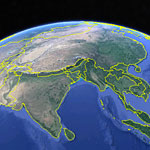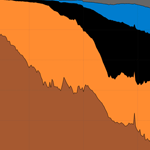| HIGHLIGHTS Index | Presentation | Publications | Press & News Media | Data | Infographics | Images | Visualisations |
Global Carbon Budget
Summary Highlights
|
Fossil CO2 emissions |
Preliminary data for 2022 show an increase in fossil CO2 emissions relative to 2021 of +1.0% (range 0.1% to 1.9%) globally, primarily driven by growth in oil use from the delayed rebound of aviation since the COVID-19 pandemic. 2020 emissions declined 5.4% from 2019 levels because of COVID-19 measures. The latest data confirm that the rate of increase in fossil CO2 emissions has slowed, from 3% per year during the 2000s to about +0.5% per year in the past decade. |
|
|
Regional fossil fuel emissions |
Emissions for 2022 are projected to decrease in China and in the European Union, but increase in the United States, India, and the Rest of the World. Fossil CO2 emissions decreased in 24 countries during the decade 2012-2021 while their economies grew. Altogether, these 24 countries contribute about one quarter of world CO2 fossil emissions. |
|
|
Emissions from land-use change |
CO2 emissions from land-use change are projected to be 3.9 GtCO2 in 2022, ten times less than fossil emissions, with a small but uncertain decline over the past two decades. The highest net CO2 emissions from land-use change during 2012-2021 are Indonesia and Brazil, which together with the Democratic Republic of the Congo contribute more than half (58%) of the global total land-use emissions. Total anthropogenic CO2 emissions (fossil and land-use change) are projected to reach 40.6 GtCO2 in 2022, slightly above their 2021 level of 40.2 GtCO2 but still below the 2019 level of 40.9 GtCO2. |
|
|
CO2 removals by land and ocean natural sinks |
The land and ocean CO2 sinks combined continued to take up around half (53% over the past decade) of the CO2 emitted to the atmosphere, despite the negative impact of climate change. The ocean CO2 sink was 10.5 GtCO2 per year during the decade 2012-2021 (26% of total CO2 emissions), with a similar preliminary estimate of 10.5 GtCO2 for 2022. The land CO2 sink was 11.4 GtCO2 per year during the 2012-2021 decade (29% of total CO2 emissions), 1.4 GtCO2 per year larger than during the 2000s, with a preliminary 2022 estimate of around 12.4 GtCO2. Climate change reduced the uptake of CO2 by the ocean and land sinks by an estimated 4% and 17% respectively over the 2012-2021 decade. |
|
|
Atmospheric CO2 |
The level of CO2 continued to increase in the atmosphere because of continued CO2 emissions. Atmospheric CO2 concentration increased 2.5 parts per million in 2021 and is projected to increase by 2.5 parts per million (19.5 GtCO2) in 2022 to reach 417.2 parts per million averaged over the year, 51% above its pre-industrial level. |
|
|
Progress since the Paris Agreement |
The remaining carbon budget for a 50% likelihood to limit global warming to 1.5°C, 1.7°C and 2°C has respectively reduced to 380 GtCO2 (9 years at 2022 emissions levels), 730 GtCO2 (18 years) and 1230 GtCO2 (30 years). Reaching zero CO2 emissions by 2050 entails a total anthropogenic CO2 emissions linear decrease by about 1.4 GtCO2 each year, comparable to the observed fall in 2020 emissions resulting from COVID-19 measures, highlighting the scale of the action needed. This would result in additional emissions of 560 GtCO2 from year 2023, leading to a 50% likelihood to limit warming to around 1.6°C. |






